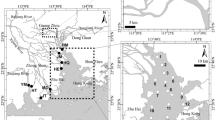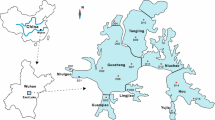Abstract
Occurrence and distribution of eight selected endocrine-disrupting compounds (EDCs), including estrone (E1), 17α-ethinylestradiol (EE2), 17α-estradiol (αE2), 17β-estradiol (βE2), estriol (E3), bisphenol A (BPA), 4-nonylphenol (NP), and 4-octylphenol (OP), were investigated in surface water and sediments of the Three Gorges Reservoir region (TGRR). The mean concentrations of E1, αE2, βE2, E3, EE2, BPA, NP, and OP were 10.3, 3.3, 3.7, 17.2, 7.8, 26.6, 10.8, and 32.3 ng L−1 respectively in surface water and 2.6, 4.1, 7.7, 2.4, 11.8, 17.4, 5.0, and 5.3 ng g−1 dry weight (dw) respectively in sediments. BPA, NP, and OP were the main EDCs in both media. Distributions of EDCs in surface water and sediments varied significantly in space but not synchronously. The higher EDCs abundance was found in the upstream water of the TGRR. EDCs concentrations in sediments had no correlations with those in water and the total organic carbon content in sediments. EDCs presented low to high risks in the water, and steroidal estrogens were the main contributors to the total estrogenic activities.



Similar content being viewed by others
References
Benotti MJ, Trenholm RA, Vanderford BJ, Holady JC, Stanford BD, Snyder SA (2008) Pharmaceuticals and endocrine disrupting compounds in US drinking water. Environ Sci Technol 43:597–603
Brian JV, Harris CA, Scholze M, Backhaus T, Booy P, Lamoree M, Pojana G, Jonkers N, Runnalls T, Bonfà A et al (2005) Accurate prediction of the response of freshwater fish to a mixture of estrogenic chemicals. Environ Health Perspect 113:721–728
Campbell CG, Borglin SE, Green FB, Grayson A, Wozei E, Stringfellow WT (2006) Biologically directed environmental monitoring, fate, and transport of estrogenic endocrine disrupting compounds in water: a review. Chemosphere 65:1265–1280
Cornelissen G, Gustafsson Ö, Bucheli TD, Jonker MT, Koelmans AA, van Noort PC (2005) Extensive sorption of organic compounds to black carbon, coal, and kerogen in sediments and soils: mechanisms and consequences for distribution, bioaccumulation, and biodegradation. Environ Sci Technol 39:6881–6895
Esteban S, Gorga M, Petrovic M, González-Alonso S, Barceló D, Valcárcel Y (2014) Analysis and occurrence of endocrine-disrupting compounds and estrogenic activity in the surface waters of Central Spain. Sci Total Environ 466:939–951
Ge J, Yun X, Liu M, Yang Y, Zhang M, Wang J (2014) Distribution, potential source and ecotoxicological risk of polychlorinated biphenyls and polybrominated diphenyl ethers in the surface water of the Three Gorges Dam region of the Yangtze River, China. Ecotoxicology 23:978–987
Gross-Sorokin MY, Roast SD, Brighty GC (2005) Assessment of feminization of male fish in English Rivers by the environment agency of England and Wales. Environ Health Perspect 114:147–151
Han L, Gao B, Wei X, Gao L, Xu D, Sun K (2015) The characteristic of Pb isotopic compositions in different chemical fractions in sediments from Three Gorges Reservoir, China. Environ Pollut 206:627–635
Heemken O, Reincke H, Stachel B, Theobald N (2001) The occurrence of xenoestrogens in the Elbe River and the North Sea. Chemosphere 45:245–259
Hibberd A, Maskaoui K, Zhang Z, Zhou J (2009) An improved method for the simultaneous analysis of phenolic and steroidal estrogens in water and sediment. Talanta 77:1315–1321
Hintemann T, Schneider C, Schöler HF, Schneider RJ (2006) Field study using two immunoassays for the determination of estradiol and ethinylestradiol in the aquatic environment. Water Res 40:2287–2294
Hohenblum P, Gans O, Moche W, Scharf S, Lorbeer G (2004) Monitoring of selected estrogenic hormones and industrial chemicals in groundwaters and surface waters in Austria. Sci Total Environ 333:185–193
Jenkins S, Betancourt AM, Wang J, Lamartiniere CA (2012) Endocrine-active chemicals in mammary cancer causation and prevention. J Steroid Biochem 129:191–200
Jiang W, Yan Y, Ma M, Wang D, Luo Q, Wang Z, Satyanarayanan SK (2012) Assessment of source water contamination by estrogenic disrupting compounds in China. J Environ Sci China 24:320–328
Johnson A, White C, Besien T, Jürgens M (1998) The sorption potential of octylphenol, a xenobiotic oestrogen, to suspended and bed-sediments collected from industrial and rural reaches of three English Rivers. Sci Total Environ 210:271–282
Lai KM, Johnson KL, Scrimshaw MD, Lester JN (2000) Binding of waterborne steroid estrogens to solid phases in river and estuarine systems. Environ Sci Technol 34:3890–3894
Lei B, Huang S, Zhou Y, Wang D, Wang Z (2009) Levels of six estrogens in water and sediment from three rivers in Tianjin area, China. Chemosphere 76:36–42
Li D, Dong M, Shim WJ, Yim UH, Hong SH, Kannan N (2008) Distribution characteristics of nonylphenolic chemicals in Masan Bay environments, Korea. Chemosphere 71:1162–1172
Li Y, Gao S, Liu S, Liu B, Zhang X, Gao M, Cheng L, Hu B (2015) Excretion of manure-borne estrogens and androgens and their potential risk estimation in the Yangtze River Basin. J Environ Sci (China) 37:110–117
Liu M, Yang Y, Yun X, Zhang M, Wang J (2015) Occurrence and assessment of organochlorine pesticides in the agricultural topsoil of Three Gorges Dam region, China. Environ Earth Sci 74:5001–5008
Lu GH, Song WT, Wang C, Yan ZH (2010) Assessment of in vivo estrogenic response and the identification of environmental estrogens in the Yangtze River (Nanjing section). Chemosphere 80:982–990
Luo Y, Guo W, Ngo HH, Nghiem LD, Hai FI, Zhang J, Liang S, Wang XC (2014) A review on the occurrence of micropollutants in the aquatic environment and their fate and removal during wastewater treatment. Sci Total Environ 473–474:619–641
Micić V, Hofmann T (2009) Occurrence and behaviour of selected hydrophobic alkylphenolic compounds in the Danube River. Environ Pollut 157:2759–2768
Migliarini B, Piccinetti C, Martella A, Maradonna F, Gioacchini G, Carnevali O (2011) Perspectives on endocrine disruptor effects on metabolic sensors. Gen Comp Endocr 170:416–423
Miller JV, Staples C (2005) Review of the potential environmental and human health–related hazards and risks from long-term exposure to p-tert-octylphenol. Hum Ecol Risk Assess 11:319–351
Mills LJ, Chichester C (2005) Review of evidence: are endocrine-disrupting chemicals in the aquatic environment impacting fish populations? Sci Total Environ 343:1–34
Nie M, Yan C, Dong W, Liu M, Zhou J, Yang Y (2015) Occurrence, distribution and risk assessment of estrogens in surface water, suspended particulate matter, and sediments of the Yangtze estuary. Chemosphere 127:109–116
Pal A, Gin KY-H, Lin AY-C, Reinhard M (2010) Impacts of emerging organic contaminants on freshwater resources: review of recent occurrences, sources, fate and effects. Sci Total Environ 408:6062–6069
Payne J, Scholze M, Kortenkamp A (2001) Mixtures of four organochlorines enhance human breast cancer cell proliferation. Environ Health Perspect 109:391–397
Petrovic M, Eljarrat E, de Alda MJL, Barcelo D (2002) Recent advances in the mass spectrometric analysis related to endocrine disrupting compounds in aquatic environmental samples. J Chromatogr A 974:23–51
Rochester JR (2013) Bisphenol A and human health: a review of the literature. Reprod Toxicol 42:132–155
Schlenk D (2008) Are steroids really the cause for fish feminization? A mini-review of in vitro and in vivo guided TIEs. Mar Pollut Bull 57:250–254
Schlenk D, Sapozhnikova Y, Irwin MA, Xie L, Hwang W, Reddy S, Brownawell BJ, Armstrong J, Kelly M, Montagne DE (2005) In vivo bioassay-guided fractionation of marine sediment extracts from the Southern California Bight, USA, for estrogenic activity. Environ Toxicol Chem 24:2820–2826
Silva CP, Otero M, Esteves V (2012) Processes for the elimination of estrogenic steroid hormones from water: a review. Environ Pollut 165:38–58
Song W, Lu G, Qi P, Wang C (2011) Estrogenic effects of water from the Yangtze River (Nanjing section) on goldfish (Carassius auratus) after an early life stage exposure. J Environ Sci China 23:1179–1185
Stuart JD, Capulong CP, Launer KD, Pan X (2005) Analyses of phenolic endocrine disrupting chemicals in marine samples by both gas and liquid chromatography–mass spectrometry. J Chromatogr A 1079:136–145
Thorpe KL, Gross-Sorokin M, Johnson I, Brighty G, Tyler CR (2005) An assessment of the model of concentration addition for predicting the estrogenic activity of chemical mixtures in wastewater treatment works effluents. Environ Health Perspect 114:90–97
Tullos D (2009) Assessing the influence of environmental impact assessments on science and policy: an analysis of the Three Gorges project. J Environ Manag 90:S208–S223
Wang J, Bi Y, Pfister G, Henkelmann B, Zhu K, Schramm K-W (2009) Determination of PAH, PCB, and OCP in water from the Three Gorges Reservoir accumulated by semipermeable membrane devices (SPMD). Chemosphere 75:1119–1127
Wang J, Gao B, Zhou H, Lu J, Wang Y, Yin S, Hao H, Yuan H (2012a) Heavy metals pollution and its potential ecological risk of the sediments in Three Gorges Reservoir during its impounding Period. Environ Sci 33:1693–1699
Wang L, Ying G-G, Chen F, Zhang L-J, Zhao J-L, Lai H-J, Chen Z-F, Tao R (2012b) Monitoring of selected estrogenic compounds and estrogenic activity in surface water and sediment of the Yellow River in China using combined chemical and biological tools. Environ Pollut 165:241–249
Wang J, Bovee TF, Bi Y, Bernhoft S, Schramm KW (2014) Aryl hydrocarbon receptor (AhR) inducers and estrogen receptor (ER) activities in surface sediments of Three Gorges Reservoir, China evaluated with in vitro cell bioassays. Environ Sci Pollut Res Int 21:3145–3155
Yang Y, Cao X, Zhang M, Wang J (2015) Occurrence and distribution of endocrine-disrupting compounds in the Honghu Lake and East Dongting Lake along the Central Yangtze River, China. Environ Sci Pollut Res 22:17644–17652
Ying G-G, Kookana RS, Ru Y-J (2002) Occurrence and fate of hormone steroids in the environment. Environ Int 28:545–551
Yoon Y, Ryu J, Oh J, Choi B-G, Snyder SA (2010) Occurrence of endocrine disrupting compounds, pharmaceuticals, and personal care products in the Han River (Seoul, South Korea). Sci Total Environ 408:636–643
Young W, Whitehouse P, Johnson I (2002) Proposed predicted-no-effect-concentrations (PNECs) for natural and synthetic steroid oestrogens in surface waters. Environment Agency, Bristol
Yu Y, Huang Q, Wang Z, Zhang K, Tang C, Cui J, Feng J, Peng X (2011) Occurrence and behavior of pharmaceuticals, steroid hormones, and endocrine-disrupting personal care products in wastewater and the recipient river water of the Pearl River Delta, South China. J Environ Monit 13:871–878
Zhang Q, Lou Z (2011) The environmental changes and mitigation actions in the Three Gorges Reservoir region, China. Environ Sci Policy 14:1132–1138
Zhang C, Li Y, Wang C, Niu L, Cai W (2015a) Occurrence of endocrine disrupting compounds in aqueous environment and their bacterial degradation: a review. Crit Rev Environ Sci Technol 46:1–59
Zhang T, Ni J, Xie D (2015b) Severe situation of rural nonpoint source pollution and efficient utilization of agricultural wastes in the Three Gorges Reservoir area. Environ Sci Pollut Res Int 22:16453–16462
Zhao J-L, Ying G-G, Chen F, Liu Y-S, Wang L, Yang B, Liu S, Tao R (2011) Estrogenic activity profiles and risks in surface waters and sediments of the Pearl River system in South China assessed by chemical analysis and in vitro bioassay. J Environ Monit 13:813–821
Acknowledgments
This project was supported in part by Natural Science Key Foundation of Hubei Province of China (NO. 2014CFA114), Funding Project of Sino-Africa Joint Research Center, Chinese Academy of Sciences (Y623321K01), and the Hundred Talents Program of the Chinese Academy of Sciences (Y329671K01).
Author information
Authors and Affiliations
Corresponding author
Electronic supplementary material
Below is the link to the electronic supplementary material.
Rights and permissions
About this article
Cite this article
Wang, W., Ndungu, A.W. & Wang, J. Monitoring of Endocrine-Disrupting Compounds in Surface Water and Sediments of the Three Gorges Reservoir Region, China. Arch Environ Contam Toxicol 71, 509–517 (2016). https://doi.org/10.1007/s00244-016-0319-z
Received:
Accepted:
Published:
Issue Date:
DOI: https://doi.org/10.1007/s00244-016-0319-z




